Passion fruit planting and cultivation management
⟡ Recommended Distance About the Planting Rows and the Plants
The passion fruit has long branches and vines, as a result, the most suitable distance between each planting row will be 3 meters, and 3-4 meters between each plant. At present, farmers mostly use planting methods that are renewed the plant every year. Therefore, some farmers will shorten the distance between each plant, they will plant at a distance of 2.5*2.5 meters in order to achieve greater production per unit area. However, it is recommended not to reduce it too much to avoid mutual shading affecting passion fruit’s growth.
⟡ Fertilizer Application Before Planting
If organic matter or animal manure has been applied as base fertilizer before planting, please confirm whether it has been completely fermented (because the fermentation process will generate heat), and do not use too much. If it is applied to the soil before fermentation is complete, it will easily affect the plant roots and cause poor growth.
⟡ Soil and Drainage Conditions
The passion fruit does not have high soil requirements. The pH value from 5.5 to 7.5 is the most suitable. Field drainage is relatively important. The farmer need to pay attention to whether the field drainage is good or not. Fields that are prone to flooding or have poor drainage are less suitable for planting the passion fruit.
⟡ How long after planting can use fertilizer, fungicides and insecticides?
1.After planting two weeks, liquid fertilizer with root opening effect can be added (it is recommended to dilute the concentration appropriately and do not use too high a concentration).
2.Granular fertilizer is recommended to be applied two weeks after planting until the plant growth is stable.
3.Foliar fertilizer can be applied once a week or every two weeks.
⟡ Plant Growth Period
Fertilizers with a higher nitrogen content can be applied to promote growth. After the passion fruit are being put into the shed, the proportion of nitrogen fertilizer can be reduced and phosphorus fertilizer and potassium fertilizer can be increased instead to avoid the proliferation of excessive and leggy branches, so as to facilitate the differentiation of flower buds and promote flowering.
Fertilizers with higher proportions of potassium, calcium, and magnesium can be applied during the fruiting period, either liquid foliar fertilizer or granular fertilizer.
Pay attention to water control during the fruiting period. Too much water will cause fruit cracking, root rot or fruit drop. Lacking of water will affect fruit size and fruit shrinkage.
⟡ Pesticide Application
After planting, you can spray bactericidal or insecticides. If it is cultivated in the open air in the early stage of planting, it is recommended to spray insecticides (organic or chemical) every week or every other week. In the rainy season or continuous rainfall, it is recommended to sterilize after the rain. This way can help the plant to avoid diseases.
⟡ Common Pests and Diseases of Passion Fruit
Common diseases of passion fruit are Anthracnose, Phytophthora blight, virus diseases and collar rot.

Figure 1 Anthracnose
Symptoms of Anthracnose-infected leaves include dark brown lesions and yellow halos on the periphery of the leaves. Many tiny black spots can be seen on them, which are the conidial discs of the pathogenic bacteria.
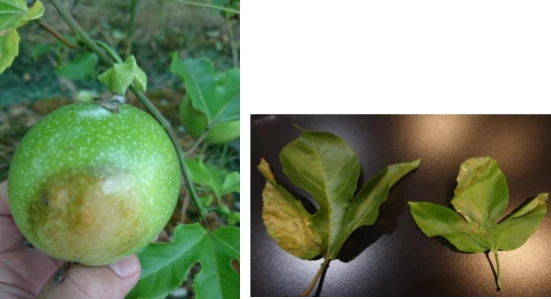
Figure 2 Phytophthora blight
Symptoms of Phytophthora blight-infected will happen in leaf margins and fruits. It will present the symptoms like water-soaked and softening symptoms.
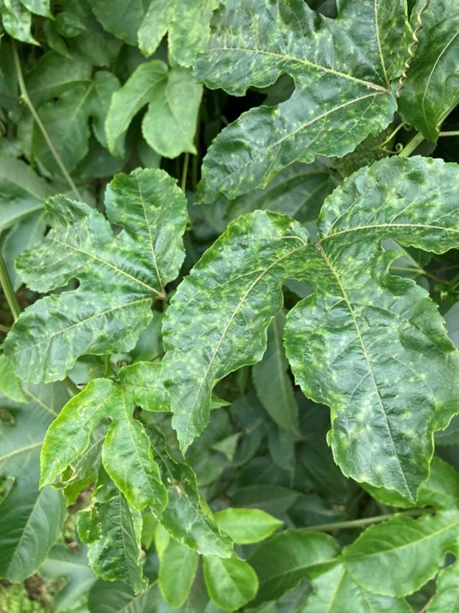
Figure 3 virus diseases
Leaves infected with the virus diseases will appear to be unevenly yellow and green, with uneven surfaces, wrinkles or deformities.
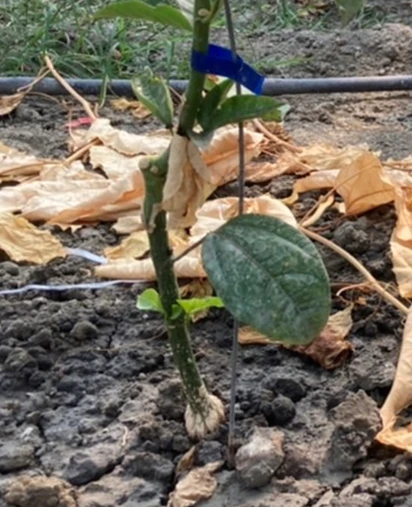
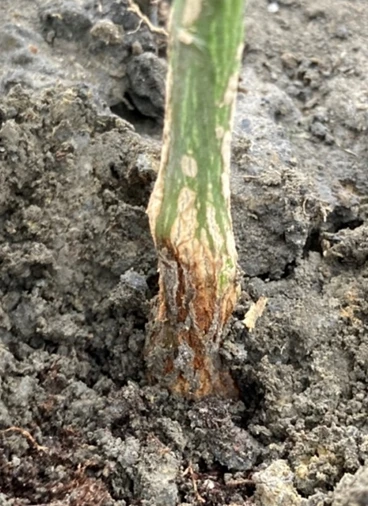
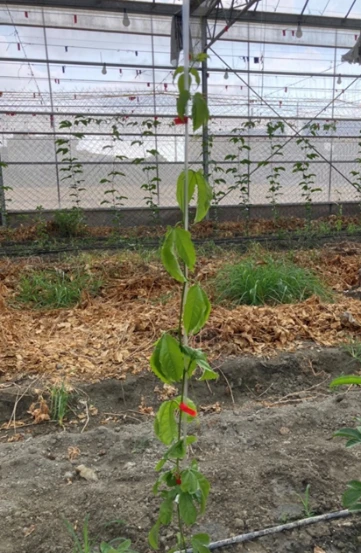
Figure 4 collar rot
Collar rot mainly occurs at the junction between the base of the plant stem and the ground. The base of the stem swells and cracks, which affects the water and nutrient transport of the plant and gradually causes wilting.
For pests, it is recommended to control thrips, mites, and aphids (because they can spread viruses), and to control fruit flies during the flowering and fruiting period to avoid biting the fruits. Since each crop has different susceptibility to drugs, it is recommended to go to a nearby pesticide store to ask for recommended pesticides, or use pesticides that have been used before and are harmless. Before application, it is recommended to test the dilution ratio on a small area and observe for a week whether there is any phytotoxicity. After observation and confirmation, it can be applied to a large area.
⟡ Recommended Distance About the Planting Rows and the Plants
The passion fruit has long branches and vines, as a result, the most suitable distance between each planting row will be 3 meters, and 3-4 meters between each plant. At present, farmers mostly use planting methods that are renewed the plant every year. Therefore, some farmers will shorten the distance between each plant, they will plant at a distance of 2.5*2.5 meters in order to achieve greater production per unit area. However, it is recommended not to reduce it too much to avoid mutual shading affecting passion fruit’s growth.
⟡ Fertilizer Application Before Planting
If organic matter or animal manure has been applied as base fertilizer before planting, please confirm whether it has been completely fermented (because the fermentation process will generate heat), and do not use too much. If it is applied to the soil before fermentation is complete, it will easily affect the plant roots and cause poor growth.
⟡ Soil and Drainage Conditions
The passion fruit does not have high soil requirements. The pH value from 5.5 to 7.5 is the most suitable. Field drainage is relatively important. The farmer need to pay attention to whether the field drainage is good or not. Fields that are prone to flooding or have poor drainage are less suitable for planting the passion fruit.
⟡ How long after planting can use fertilizer, fungicides and insecticides?
1.After planting two weeks, liquid fertilizer with root opening effect can be added (it is recommended to dilute the concentration appropriately and do not use too high a concentration).
2.Granular fertilizer is recommended to be applied two weeks after planting until the plant growth is stable.
3.Foliar fertilizer can be applied once a week or every two weeks.
⟡ Plant Growth Period
Fertilizers with a higher nitrogen content can be applied to promote growth. After the passion fruit are being put into the shed, the proportion of nitrogen fertilizer can be reduced and phosphorus fertilizer and potassium fertilizer can be increased instead to avoid the proliferation of excessive and leggy branches, so as to facilitate the differentiation of flower buds and promote flowering.
Fertilizers with higher proportions of potassium, calcium, and magnesium can be applied during the fruiting period, either liquid foliar fertilizer or granular fertilizer.
Pay attention to water control during the fruiting period. Too much water will cause fruit cracking, root rot or fruit drop. Lacking of water will affect fruit size and fruit shrinkage.
⟡ Pesticide Application
After planting, you can spray bactericidal or insecticides. If it is cultivated in the open air in the early stage of planting, it is recommended to spray insecticides (organic or chemical) every week or every other week. In the rainy season or continuous rainfall, it is recommended to sterilize after the rain. This way can help the plant to avoid diseases.
⟡ Common Pests and Diseases of Passion Fruit
Common diseases of passion fruit are Anthracnose, Phytophthora blight, virus diseases and collar rot.

Figure 1 Anthracnose
Symptoms of Anthracnose-infected leaves include dark brown lesions and yellow halos on the periphery of the leaves. Many tiny black spots can be seen on them, which are the conidial discs of the pathogenic bacteria.

Figure 2 Phytophthora blight
Symptoms of Phytophthora blight-infected will happen in leaf margins and fruits. It will present the symptoms like water-soaked and softening symptoms.

Figure 3 virus diseases
Leaves infected with the virus diseases will appear to be unevenly yellow and green, with uneven surfaces, wrinkles or deformities.



Figure 4 collar rot
Collar rot mainly occurs at the junction between the base of the plant stem and the ground. The base of the stem swells and cracks, which affects the water and nutrient transport of the plant and gradually causes wilting.
For pests, it is recommended to control thrips, mites, and aphids (because they can spread viruses), and to control fruit flies during the flowering and fruiting period to avoid biting the fruits. Since each crop has different susceptibility to drugs, it is recommended to go to a nearby pesticide store to ask for recommended pesticides, or use pesticides that have been used before and are harmless. Before application, it is recommended to test the dilution ratio on a small area and observe for a week whether there is any phytotoxicity. After observation and confirmation, it can be applied to a large area.

